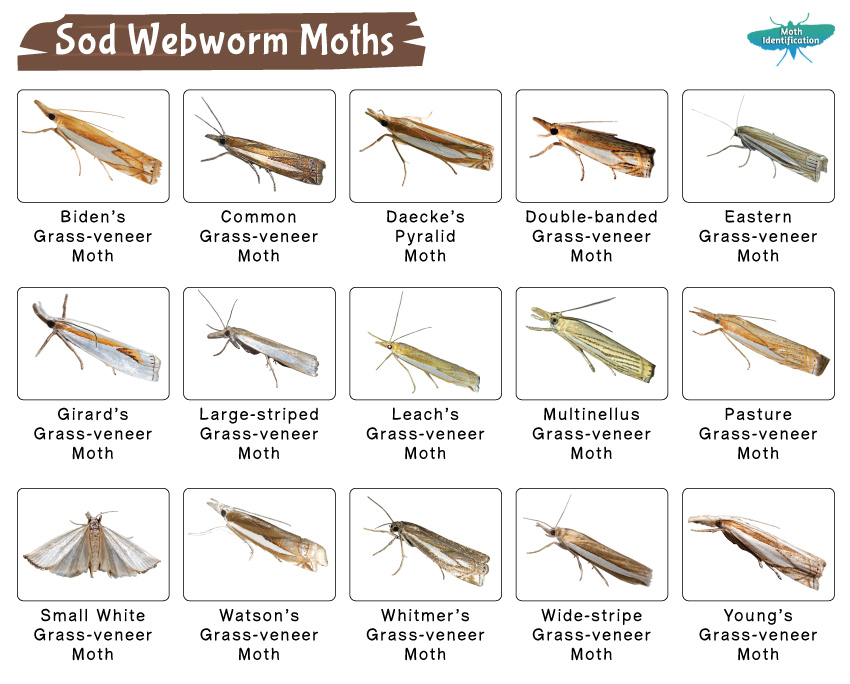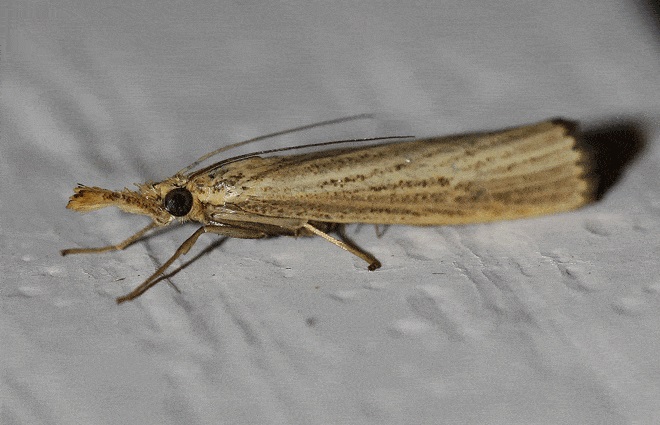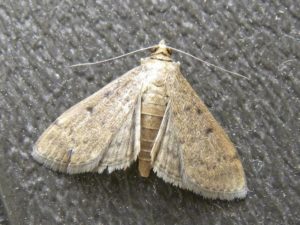Sod Webworm Moths (Crambus)
The sod webworm moth is a genus belonging to the family of grass moths. The larvae are mostly called sod webworms, which give the genus its name.
List of Species in this Genus
- Double-banded Grass-veneer Moth (Crambus agitatellus)
- Small White Grass-veneer Moth (Crambus albellus)
- Biden’s Grass-veneer Moth (Crambus bidens)
- Daecke’s Pyralid Moth (Crambus daeckellus)
- Girard’s Grass-veneer Moth (Crambus girardellus)
- Leach’s Grass-veneer Moth (Crambus leachellus)
- Eastern Grass-veneer Moth (Crambus laqueatellus)
- Multinellus Grass-veneer Moth (Crambus multilinellus)
- Whitmer’s Grass-veneer Moth (Crambus whitmerellus)
- Common Grass-veneer Moth (Crambus praefectellus)
- Large-striped Grass-veneer Moth (Crambus quinquareatus)
- Pasture Grass-veneer Moth (Crambus saltuellus)
- Wide-stripe Grass-veneer Moth (Crambus unistriatellus)
- Watson’s Grass-veneer Moth (Crambus watsonellus)
- Young’s Grass-veneer Moth (Crambus youngellus)
- Crambus ainslieellus
- Crambus achilles
- Crambus acyperas
- Crambus albifrons
- Crambus alexandrus
- Crambus alienellus
- Crambus angulatus
- Crambus angustalatellus
- Crambus angustexon
- Crambus archimedes
- Crambus argyrophorus
- Crambus aristophanes
- Crambus arnaudiae
- Crambus athamas
- Crambus attis
- Crambus autotoxellus
- Crambus averroellus
- Crambus awemellus
- Crambus bachi
- Crambus bellinii
- Crambus bellissimus
- Crambus berliozi
- Crambus bidentellus
- Crambus bigelovi
- Crambus bipartellus
- Crambus boislamberti
- Crambus brachiiferus
- Crambus braunellus
- Crambus brunneisquamatus
- Crambus caligula
- Crambus claviger
- Crambus coccophthorus
- Crambus cockleellus
- Crambus cormieri
- Crambus coryolanus
- Crambus cypridalis
- Crambus cyrilellus
- Crambus cyrnellus
- Crambus damotellus
- Crambus dedalus
- Crambus delineatellus
- Crambus descarpentriesi
- Crambus dianiphalis
- Crambus diarhabdellus
- Crambus dimidiatellus
- Crambus ellipticellus
- Crambus elongatus
- Crambus erechtheus
- Crambus ericella
- Crambus erostratus
- Crambus eurypides
- Crambus falcarius
- Crambus frescobaldii
- Crambus gausapalis
- Crambus geleches
- Crambus guerini
- Crambus hamella
- Crambus hampsoni
- Crambus harrisi
- Crambus hastifer
- Crambus hemileucalis
- Crambus heringiellus
- Crambus humidellus
- Crambus icarus
- Crambus isshiki
- Crambus johnsoni
- Crambus jupiter
- Crambus kazitaellus
- Crambus kumatakellus
- Crambus kuzakaiensis
- Crambus lacteella
- Crambus lascaellus
- Crambus lathoniellus
- Crambus leuconotus
- Crambus leucoschalis
- Crambus lyonsellus
- Crambus magnificus
- Crambus melanoneurus
- Crambus mesombrellus
- Crambus microstrigatus
- Crambus midas
- Crambus moeschleralis
- Crambus monostictus
- Crambus mozarti
- Crambus multiradiellus
- Crambus narcissus
- Crambus nephretete
- Crambus netuncus
- Crambus neurellus
- Crambus nigriscriptellus
- Crambus nigrivarialis
- Crambus niitakaensis
- Crambus nivellus
- Crambus nolckeniellus
- Crambus occidentalis
- Crambus okinawanus
- Crambus ovidius
- Crambus palustrellus
- Crambus paris
- Crambus pascuella
- Crambus patulellus
- Crambus pavidellus
- Crambus perlella
- Crambus perspicuus
- Crambus pratella
- Crambus prometheus
- Crambus proteus
- Crambus pseudargyrophorus
- Crambus psychellus
- Crambus puccinii
- Crambus pythagoras
- Crambus racabellus
- Crambus reducta
- Crambus richteri
- Crambus rickseckerellus
- Crambus rossinii
- Crambus sachaensis
- Crambus sanfordellus
- Crambus sapidus
- Crambus sargentellus
- Crambus satrapellus
- Crambus sebrus
- Crambus sectitermina
- Crambus sibirica
- Crambus silvella
- Crambus sinicolellus
- Crambus sjoestedti
- Crambus sparselloides
- Crambus sparsellus
- Crambus sperryellus
- Crambus sudanicola
- Crambus tenuis
- Crambus tenuistriga
- Crambus tessellatus
- Crambus themistocles
- Crambus thersites
- Crambus theseus
- Crambus tomanaellus
- Crambus trichusalis
- Crambus tutillus
- Crambus uliginosellus
- Crambus uniformella
- Crambus vagistrigellus
- Crambus varii
- Crambus viettellus
- Crambus virgatellus
- Crambus vittiterminellus
- Crambus vulcanus
- Crambus whalleyi
- Crambus xonorus
- Crambus zelator
Description and Identification
Caterpillar
The larvae’s colors vary from beige to brown, to green, or even gray. Most of them also have circular, dark spots all over their body. The larvae are initially 0.9-1.3 cm, and by the final instar, they measure around 2.4-2.8 cm long. From the first to third instar, the head capsule remains black, but those of the later instars is more light brown with black sculpturation.
Scientific Classification
- Family: Crambidae
- Genus: Crambus
Pupa
Initially, the pupa is pale yellow before darkening to a mahogany brown. The cocoon comprises soil, feces, and plant litter resembling a small earthen lump. The pupae are 0.8-1 cm long and 0.25 cm wide.
Adult Moth
Sexual Dimorphism: There are no significant differences between the male and female moths.
Color and Appearance
Forewing: When opened, the wings are either brown or ash gray. There is a white streak running from the base of the wing to the margin. This streak remains visible even when the wings remain closed.
Hindwings: When opened, they are brownish. When closed, the color is no longer visible.
Average wingspan: 2-2.5 cm
Flight pattern: Erratic
Season: July to August
Egg
The eggs are creamy white, later turning bright orange or red. They are not spherical, instead having a more elliptical or oval shape. These 0.3-0.6 mm long eggs do not stick to each other and are completely dry.
Quick Facts
| Distribution | The United States |
| Habitat | Grass, such as field and turfgrass |
| Lifespan of Adults | Around 1 year |
| Predators | Birds, bats |
| Host Plants | Grass |
| Adult Diet | Nectar |
Scientific Classification
- Family: Crambidae
- Genus: Crambus





